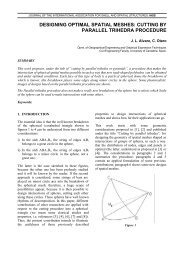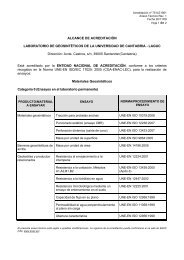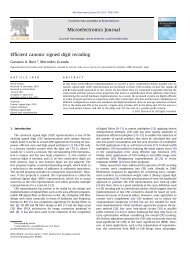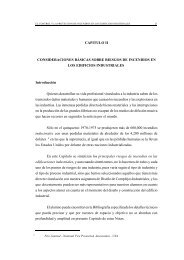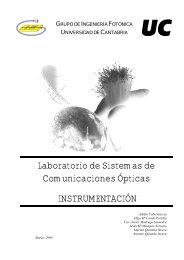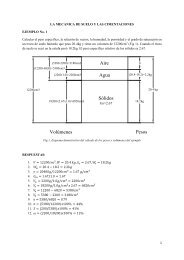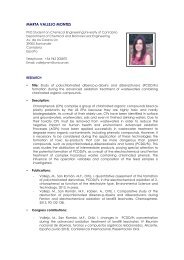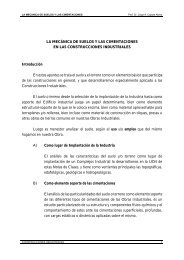XXXVII <str<strong>on</strong>g>IAHS</str<strong>on</strong>g><str<strong>on</strong>g>World</str<strong>on</strong>g> <str<strong>on</strong>g>C<strong>on</strong>gress</str<strong>on</strong>g> <strong>on</strong> <strong>Housing</strong>October 26 – 29, 2010, Santan<strong>de</strong>r, SpainCODE: 407FIRE RISK ANALYSIS IN BUILDINGSAntónio Leça Coelho i , João Paulo Correia Rodrigues iiiLaboratório Naci<strong>on</strong>al <strong>de</strong> Engenharia Civil, Lisboa, PortugaliiFaculda<strong>de</strong> <strong>de</strong> Ciências e Tecnologia da <strong>Universidad</strong>e <strong>de</strong> Coimbrae-mail: alcoelho@lnec.ptKey words: Buldings, mo<strong>de</strong>ls, fire risk, emergency, egress.AbstractThe Laboratório Naci<strong>on</strong>al <strong>de</strong> Engenharia Civil – LNEC has launched, about 12 years ago, the<strong>de</strong>velopment of an overall mo<strong>de</strong>l of analysis to the fire risk in buildings.The mo<strong>de</strong>l was formed by 11 partial mo<strong>de</strong>ls (mo<strong>de</strong>l <strong>de</strong>scribing the building, mo<strong>de</strong>l of thebuilding evacuati<strong>on</strong>, mo<strong>de</strong>l of the probability of occurrence of fire in the building, mo<strong>de</strong>l of<strong>de</strong>velopment of fire in the building, mo<strong>de</strong>l of structural safety of the building, mo<strong>de</strong>l of firewarning and <strong>de</strong>tecti<strong>on</strong>, mo<strong>de</strong>l of automatic fire extincti<strong>on</strong> means, mo<strong>de</strong>l of fire briga<strong>de</strong>sassociated with the building, mo<strong>de</strong>l of reliability of the active protecti<strong>on</strong> systems, mo<strong>de</strong>l ofcost-advantage analysis, mo<strong>de</strong>l of data management produced by the partial mo<strong>de</strong>ls).This communicati<strong>on</strong> is a <strong>de</strong>scripti<strong>on</strong> of the evoluti<strong>on</strong> of the mo<strong>de</strong>l over these 12 years.37º <str<strong>on</strong>g>IAHS</str<strong>on</strong>g> <str<strong>on</strong>g>World</str<strong>on</strong>g> <str<strong>on</strong>g>C<strong>on</strong>gress</str<strong>on</strong>g> On <strong>Housing</strong> Science 199
XXXVII <str<strong>on</strong>g>IAHS</str<strong>on</strong>g><str<strong>on</strong>g>World</str<strong>on</strong>g> <str<strong>on</strong>g>C<strong>on</strong>gress</str<strong>on</strong>g> <strong>on</strong> <strong>Housing</strong>October 26 – 29, 2010, Santan<strong>de</strong>r, SpainCODE: 408DETACHMENT OF PLASTERS APPLIED ON CEILINGS ANDWALLS: A SAFETY PROBLEMVeiga, Maria do Rosário 1 ; Malanho, Sofia 21, 2Buildings DepartmentLaboratório Naci<strong>on</strong>al <strong>de</strong> Engenharia Civil (LNEC)e-mail: 1 rveiga@lnec.pt; 2 smalanho@lnec.ptKey words: <strong>de</strong>tachments, plasters, in situ testsAbstractThe loss of adhesi<strong>on</strong> of plasters has as a c<strong>on</strong>sequence the separati<strong>on</strong> between mortar andsupport, an anomaly <strong>de</strong>signated as <strong>de</strong>tachment; which may endanger the users’ safety.The loss of adhesi<strong>on</strong> can appear due to different factors: problems related to the background(dust, <strong>de</strong>moulding oil, poor sucti<strong>on</strong> or excessive sucti<strong>on</strong>, etc.); problems related with theplaster compositi<strong>on</strong>, as the use of hydrophobic admixtures; problems related to applicati<strong>on</strong>(high thickness of the plaster coat, absence of an adhesi<strong>on</strong> coat, disrespect for drying periodsbetween coats, etc.).This problem is getting more and more important nowadays, because of short times forc<strong>on</strong>structi<strong>on</strong>, untrained workmanship and the ten<strong>de</strong>ncy to use hydrophobic materials andsmooth surfaces. The fall of a fragment of heavy mortar from the ceiling of a house or froman external high wall can seriously hurt the users, or even kill somebody, thus theun<strong>de</strong>rstanding of causes and the specificati<strong>on</strong> of preventive measures is a safety issue.This paper presents an analysis of this problem, showing shortly some examples and theircauses and <strong>de</strong>scribing a case study about the <strong>de</strong>tachment of a cement ceiling plaster.C<strong>on</strong>cerning the case study, an experimental analysis was <strong>de</strong>veloped with the purpose to<strong>de</strong>termine adhesi<strong>on</strong> <strong>de</strong>gree in the remaining plasters and to i<strong>de</strong>ntify the cause of the anomaly.In situ pull-off tests were carried out and compared with reference values and a set oflaboratory tests were accomplished to acknowledge the influence of each factor. The testsresults permitted the <strong>de</strong>finiti<strong>on</strong> of the functi<strong>on</strong>al capacity of the plasters and the planning ofrepair acti<strong>on</strong>s.37º <str<strong>on</strong>g>IAHS</str<strong>on</strong>g> <str<strong>on</strong>g>World</str<strong>on</strong>g> <str<strong>on</strong>g>C<strong>on</strong>gress</str<strong>on</strong>g> On <strong>Housing</strong> Science 200
- Page 1 and 2:
University ofCantabriawww.iahshousi
- Page 3 and 4:
ÍNDICE1. HONORARY COMMITTEE ______
- Page 5 and 6:
2. INTRODUCTIONThe International As
- Page 7:
4. ENTIDADES COLABORADORASColegio d
- Page 10 and 11:
6. ORGANIZING COMMITTEELOCAL ORGANI
- Page 12 and 13:
8. TOPICS - STATISTICSTOPIC I: MATE
- Page 14 and 15:
also the Spanish aristocracy used t
- Page 16 and 17:
11. CONFERENCE ROOMSThe Con
- Page 18 and 19:
Also, the Congress
- Page 20 and 21:
13. PLENARY SESSIONSPLENARY SESSION
- Page 22 and 23:
October 26, 9 h 30-10 h 00 (Room 0)
- Page 24 and 25:
October 26, 10 h 30-11 h 00 (Room 0
- Page 26 and 27:
October 27, 9 h 30-10 h 00 (Room 0)
- Page 28 and 29:
October 27, 10 h 30-11 h 00 (Room 0
- Page 30 and 31:
October 28, 9 h 30-10 h 00 (Room 0)
- Page 32 and 33:
October 28, 10 h 30-11 h 00 (Room 0
- Page 34 and 35:
October 26, 201011 h 30-13 h 30 Cha
- Page 36 and 37:
October 26, 201011 h 30-13 h 30 Cha
- Page 38 and 39:
October 27, 201011 h 30-13 h 30 Cha
- Page 40 and 41:
October 27, 201011 h 30-13 h 30 Cha
- Page 42 and 43:
October 28, 201011 h 30-13 h 30 Cha
- Page 44 and 45:
October 28, 201011 h 30-13 h 30 Cha
- Page 46 and 47:
16. TECHNICAL EXPOSITION (STANDS)37
- Page 48 and 49:
TRIP A: MARITIME MUSEUM + PEDREÑA
- Page 50 and 51:
RECEPTION COCKTAIL BY THE MAYOR OFS
- Page 52 and 53:
37º IAHS
- Page 54 and 55:
GALA DINNERDía 28 de OctubrePassin
- Page 56 and 57:
37º IAHS
- Page 58 and 59:
19. ABSTRACTS OF THE CONGRESSABSTRA
- Page 60 and 61:
XXXVII IAHS<strong
- Page 62 and 63:
XXXVII IAHS<strong
- Page 64 and 65:
XXXVII IAHS<strong
- Page 66 and 67:
XXXVII IAHS<strong
- Page 71 and 72:
XXXVII IAHS<strong
- Page 73 and 74:
XXXVII IAHS<strong
- Page 75 and 76:
XXXVII IAHS<strong
- Page 77 and 78:
XXXVII IAHS<strong
- Page 79 and 80:
XXXVII IAHS<strong
- Page 81 and 82:
XXXVII IAHS<strong
- Page 83 and 84:
XXXVII IAHS<strong
- Page 85 and 86:
XXXVII IAHS<strong
- Page 87 and 88:
XXXVII IAHS<strong
- Page 89 and 90:
XXXVII IAHS<strong
- Page 91 and 92:
XXXVII IAHS<strong
- Page 93 and 94:
XXXVII IAHS<strong
- Page 95 and 96:
XXXVII IAHS<strong
- Page 97 and 98:
XXXVII IAHS<strong
- Page 99 and 100:
XXXVII IAHS<strong
- Page 101 and 102:
XXXVII IAHS<strong
- Page 103 and 104:
XXXVII IAHS<strong
- Page 105 and 106:
XXXVII IAHS<strong
- Page 107 and 108:
XXXVII IAHS<strong
- Page 109 and 110:
XXXVII IAHS<strong
- Page 111 and 112:
XXXVII IAHS<strong
- Page 113 and 114:
XXXVII IAHS<strong
- Page 115 and 116:
XXXVII IAHS<strong
- Page 117 and 118:
XXXVII IAHS<strong
- Page 119 and 120:
XXXVII IAHS<strong
- Page 121 and 122:
XXXVII IAHS<strong
- Page 123 and 124:
XXXVII IAHS<strong
- Page 125 and 126:
XXXVII IAHS<strong
- Page 127 and 128:
XXXVII IAHS<strong
- Page 129 and 130:
XXXVII IAHS<strong
- Page 131 and 132:
XXXVII IAHS<strong
- Page 133 and 134:
XXXVII IAHS<strong
- Page 135 and 136:
XXXVII IAHS<strong
- Page 137 and 138:
XXXVII IAHS<strong
- Page 139 and 140:
XXXVII IAHS<strong
- Page 141 and 142:
XXXVII IAHS<strong
- Page 143 and 144:
XXXVII IAHS<strong
- Page 145 and 146:
XXXVII IAHS<strong
- Page 147 and 148:
XXXVII IAHS<strong
- Page 149 and 150:
XXXVII IAHS<strong
- Page 151 and 152: XXXVII IAHS<strong
- Page 153 and 154: XXXVII IAHS<strong
- Page 155 and 156: XXXVII IAHS<strong
- Page 157 and 158: XXXVII IAHS<strong
- Page 159 and 160: XXXVII IAHS<strong
- Page 161 and 162: XXXVII IAHS<strong
- Page 163 and 164: XXXVII IAHS<strong
- Page 165 and 166: XXXVII IAHS<strong
- Page 167 and 168: XXXVII IAHS<strong
- Page 169 and 170: XXXVII IAHS<strong
- Page 171 and 172: XXXVII IAHS<strong
- Page 173 and 174: XXXVII IAHS<strong
- Page 175 and 176: XXXVII IAHS<strong
- Page 177 and 178: XXXVII IAHS<strong
- Page 179 and 180: XXXVII IAHS<strong
- Page 181 and 182: XXXVII IAHS<strong
- Page 183 and 184: XXXVII IAHS<strong
- Page 185 and 186: XXXVII IAHS<strong
- Page 187 and 188: XXXVII IAHS<strong
- Page 189 and 190: XXXVII IAHS<strong
- Page 191 and 192: XXXVII IAHS<strong
- Page 193 and 194: XXXVII IAHS<strong
- Page 195 and 196: XXXVII IAHS<strong
- Page 197 and 198: TOPIC IV - HEALTH, COMFORT AND SAFE
- Page 199 and 200: XXXVII IAHS<strong
- Page 201: XXXVII IAHS<strong
- Page 205 and 206: XXXVII IAHS<strong
- Page 207 and 208: XXXVII IAHS<strong
- Page 209 and 210: XXXVII IAHS<strong
- Page 211 and 212: XXXVII IAHS<strong
- Page 213 and 214: XXXVII IAHS<strong
- Page 215 and 216: XXXVII IAHS<strong
- Page 217 and 218: XXXVII IAHS<strong
- Page 219 and 220: XXXVII IAHS<strong
- Page 221 and 222: XXXVII IAHS<strong
- Page 223 and 224: XXXVII IAHS<strong
- Page 225 and 226: XXXVII IAHS<strong
- Page 227 and 228: XXXVII IAHS<strong
- Page 229 and 230: XXXVII IAHS<strong
- Page 231 and 232: XXXVII IAHS<strong
- Page 233 and 234: XXXVII IAHS<strong
- Page 235 and 236: TOPIC VI - URBAN AND CITY PLANNING.
- Page 237 and 238: XXXVII IAHS<strong
- Page 239 and 240: XXXVII IAHS<strong
- Page 241 and 242: XXXVII IAHS<strong
- Page 243 and 244: XXXVII IAHS<strong
- Page 245 and 246: XXXVII IAHS<strong
- Page 247 and 248: XXXVII IAHS<strong
- Page 249 and 250: XXXVII IAHS<strong
- Page 251 and 252: XXXVII IAHS<strong
- Page 253 and 254:
XXXVII IAHS<strong
- Page 255 and 256:
XXXVII IAHS<strong
- Page 257 and 258:
XXXVII IAHS<strong
- Page 259 and 260:
XXXVII IAHS<strong
- Page 261 and 262:
XXXVII IAHS<strong
- Page 263 and 264:
XXXVII IAHS<strong
- Page 265 and 266:
TOPIC VII - ECONOMY AND FINANCING P
- Page 267 and 268:
XXXVII IAHS<strong
- Page 269 and 270:
XXXVII IAHS<strong
- Page 271 and 272:
XXXVII IAHS<strong
- Page 273 and 274:
TOPIC VIII - MANAGEMENT SCHEMES AND
- Page 275 and 276:
XXXVII IAHS<strong
- Page 277 and 278:
XXXVII IAHS<strong
- Page 279 and 280:
XXXVII IAHS<strong
- Page 281 and 282:
XXXVII IAHS<strong
- Page 283 and 284:
XXXVII IAHS<strong
- Page 285 and 286:
XXXVII IAHS<strong
- Page 287 and 288:
XXXVII IAHS<strong
- Page 289 and 290:
XXXVII IAHS<strong
- Page 291 and 292:
XXXVII IAHS<strong
- Page 293 and 294:
XXXVII IAHS<strong
- Page 295 and 296:
XXXVII IAHS<strong
- Page 297 and 298:
XXXVII IAHS<strong
- Page 299 and 300:
XXXVII IAHS<strong
- Page 301 and 302:
XXXVII IAHS<strong
- Page 303 and 304:
XXXVII IAHS<strong
- Page 305 and 306:
XXXVII IAHS<strong
- Page 307 and 308:
XXXVII IAHS<strong
- Page 309 and 310:
XXXVII IAHS<strong
- Page 311 and 312:
XXXVII IAHS<strong
- Page 313 and 314:
XXXVII IAHS<strong
- Page 315 and 316:
XXXVII IAHS<strong
- Page 317 and 318:
XXXVII IAHS<strong
- Page 319 and 320:
XXXVII IAHS<strong
- Page 321 and 322:
XXXVII IAHS<strong
- Page 323 and 324:
XXXVII IAHS<strong
- Page 325 and 326:
XXXVII IAHS<strong
- Page 327 and 328:
XXXVII IAHS<strong
- Page 329 and 330:
XXXVII IAHS<strong
- Page 331 and 332:
XXXVII IAHS<strong
- Page 333 and 334:
XXXVII IAHS<strong
- Page 335 and 336:
XXXVII IAHS<strong
- Page 337 and 338:
XXXVII IAHS<strong
- Page 339 and 340:
XXXVII IAHS<strong
- Page 341 and 342:
XXXVII IAHS<strong
- Page 343 and 344:
XXXVII IAHS<strong
- Page 345 and 346:
XXXVII IAHS<strong
- Page 347 and 348:
XXXVII IAHS<strong
- Page 349 and 350:
XXXVII IAHS<strong
- Page 351 and 352:
XXXVII IAHS<strong
- Page 353 and 354:
XXXVII IAHS<strong
- Page 355 and 356:
XXXVII IAHS<strong
- Page 357 and 358:
XXXVII IAHS<strong
- Page 359 and 360:
XXXVII IAHS<strong
- Page 361 and 362:
XXXVII IAHS<strong
- Page 363 and 364:
XXXVII IAHS<strong
- Page 365 and 366:
XXXVII IAHS<strong
- Page 367 and 368:
XXXVII IAHS<strong
- Page 369 and 370:
XXXVII IAHS<strong
- Page 371 and 372:
XXXVII IAHS<strong
- Page 373 and 374:
XXXVII IAHS<strong
- Page 375 and 376:
XXXVII IAHS<strong
- Page 377 and 378:
XXXVII IAHS<strong



